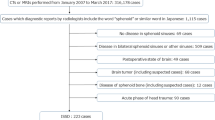Abstract
Fungus ball (FB) is the most common form of extramucosal fungal rhinosinusitis involving one or more paranasal sinuses. The sphenoid sinus is an uncommon site of this disease. Here, we present our 20-year experience of managing isolated sphenoid sinus FB (SSFB). We retrospectively reviewed a series of 47 cases of isolated SSFB encountered between 1996 and 2015 with reference to the chronological incidence, demographics, clinical features, radiological findings, treatment modalities, and outcome. Recently, the number of patients with isolated SSFB has increased markedly. The mean age of the patients in this study was 63.1 years (range 26–84 years), and there was significant female predominance. The most common symptom was headache (72.3%), which was localised in various regions. On the other hand, nasal symptoms presented at a relatively low rate. On computed tomography, the most common findings were total opacification, calcification, and sclerosis of the bony walls. There was no significant difference in the presence of SSFB between the ipsilateral and contralateral sides of the nasal septal deviation and concha bullosa. Magnetic resonance imaging demonstrated an isointensity on T1-weighted images and marked hypointensity on T2-weighted images. Treatment consisted of endonasal endoscopic sphenoidotomy with complete removal of the FB. The prognosis was good, with no recurrence after a mean follow-up of 13.2 months. Isolated SSFB is a rare disease, but its prevalence is increasing. Although the clinical presentation is usually vague and nonspecific, SSFB should be considered in patients with unexplained headache, especially in elderly women. Endoscopic sphenoidotomy is a reliable treatment with low morbidity and recurrence rates.



Similar content being viewed by others
References
Grosjean P, Weber R (2007) Fungus balls of the paranasal sinuses: a review. Eur Arch Otorhinolaryngol 264:461–470
Chakrabarti A, Denning DW, Ferguson BJ, Ponikau J, Buzina W, Kita H et al (2009 Sep) Fungal rhinosinusitis: a categorization and definitional schema addressing current controversies. Laryngoscope 119(9):1809–1818
Dufour X, Kauffmann-Lacroix C, Ferrie JC, Goujon JM, Rodier MH, Karkas A et al (2005) Paranasal sinus fungus ball and surgery: a review of 175 cases. Rhinology 43:34–39
Nicolai P, Lombardi D, Tomenzoli D, Villaret AB, Piccioni M, Mensi M et al (2009) Fungus ball of the paranasal sinuses: experience in 160 patients treated with endoscopic surgery. Laryngoscope 119:2275–2279
Pagella F, Matti E, De Bernardi F, Semino L, Cavanna C, Marone P et al (2007) Paranasal sinus fungus ball: diagnosis and management. Mycoses 50:451–456
Kim TH, Na KJ, Seok JH, Heo SJ, Park JH, Kim JS (2013) A retrospective analysis of 29 isolated sphenoid fungus ball cases from a medical centre in Korea (1999–2012). Rhinology 51:280–286
Seo YJ, Kim J, Kim K, Lee JG, Kim CH, Yoon JH (2011) Radiologic characteristics of sinonasal fungus ball: an analysis of 119 cases. Acta Radiol 52:790–795
Bowman J, Panizza B, Gandhi M (2007) Sphenoid sinus fungal balls. Ann Otol Rhinol Laryngol 116(7):514–519
Eloy P, Grenier J, Pirlet A, Poirrier AL, Stephens JS, Rombaux P (2013) Sphenoid sinus fungall ball: a retrospective study over a 10-year period. Rhinology 51(2):181–188
Karkas A, Rtail R, Reyt E, Timi N, Righini CA (2013) Sphenoid sinus fungus ball. Eur Arch Otorhinolaryngol 270:893–898
Lee DH, Joo YE, Lim SC (2013) Fungus balls of the bilateral paranasal sinuses. Indian. J Otolaryngol Head Neck Surg 65(suppl 2):S320–S323
Pagella F, Pusateri A, Matti E, Giourgos G, Cavanna C, De Bernardi F et al (2011) Sphenoid sinus fungus ball: our experience. Am J Rhinol Allergy 25:276–280
Orlandi RR (2010) A systematic analysis of septal deviation associated with rhinosinusitis. Laryngoscope 120:1687–1695
Kim JS, So SS, Kwon SH (2017) The increasing incidence of paranasal sinus fungus ball: A retrospective cohort study in two hundred forty-five patients for fifteen years. Clin Otolaryngol 42(1):175–179
Lee TJ, Huang SF, Chang PH (2009) Characteristics of isolated sphenoid sinus aspergilloma: report of twelve cases and literature review. ANN Otol Rhinol Laryngol 118(3):211–217
Leroux E, Valade D, Guichard JP, Herman P (2009) Sphenoid fungus balls: clinical presentation and long-term follow-up in 24 patients. Cephalgia 29:1218–1223
Nicolai P, Mensi M, Marsili F, Piccioni M, Salgarello S, Gilberti E et al (2015) Maxillary fungus ball: zinc-oxide endodontic materials as a risk factor. Acta Otorhinolaryngol Ital 35:93–96
Tomazic PV, Dostal E, Magyar M, Lang-Loidolt D, Wolf A, Koele W et al (2016) Potential correlations of dentogenic factors to the development of clinically verified fungus balls: a retrospective computed tomography–based analysis. Laryngoscope 126(1):39–43
Chen JC, Ho CY (2012) The significance of computed tomographic findings in the diagnosis of fungus ball in the paranasal sinuses. Am J Rhinol Allergy 26:117–119
Financial support
This paper received no specific grant from any funding agency, commercial or not-for-profit sectors.
Author information
Authors and Affiliations
Corresponding author
Ethics declarations
Conflict of interest
None.
Research involving human and animal participants
All procedures performed in studies involving human participants were in accordance with the ethical standards of the institutional and with the 1964 Helsinki declaration and its later amendments or comparable ethical standards. For this type of study formal consent is not required.
Rights and permissions
About this article
Cite this article
Lim, HS., Yoon, Y.H., Xu, J. et al. Isolated sphenoid sinus fungus ball: a retrospective study conducted at a tertiary care referral center in Korea. Eur Arch Otorhinolaryngol 274, 2453–2459 (2017). https://doi.org/10.1007/s00405-017-4468-0
Received:
Accepted:
Published:
Issue Date:
DOI: https://doi.org/10.1007/s00405-017-4468-0



